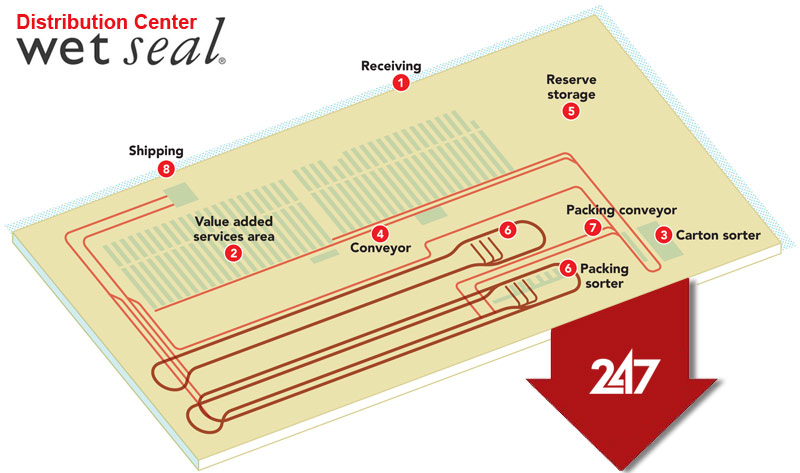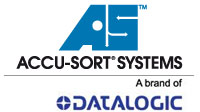An Order Fulfillment System Designed to Complement a Retailer’s Business Model
Wet Seal’s order fulfillment system speeds product from the receiving dock to shipping to keep a steady flow of new product in its stores.
Wet Seal’s distribution center is a prime example of a materials handling system designed to complement a retailer’s business model. In the case of this fast fashion retailer, the equipment, systems and processes are designed to receive, allocate, process and ship new merchandise to the retailer’s 554 stores within 24 hours of receipt.
Since Wet Seal’s business model is built around offering a constant stream of new merchandise to its customers, an estimated 90% of incoming merchandise will be allocated and shipped directly to the stores. Only a small number of basic items, such as denim jeans, are kept in reserve storage at the distribution center.

Receiving: Incoming trailers and shipping containers are processed at six dock doors dedicated to receiving (1). Wet Seal receives advance ship notices (ASN) about 24 hours in advance of delivery. That allows the receiving team to schedule enough labor to handle the anticipated volume of materials. Product is typically received on pallets. When the pallets are removed from the trailer, the receipt is counted and verified against a purchase order.
Storage/value-added processing: After the receiving process is complete, Wet Seal’s warehouse management system (WMS) allocates the merchandise across the retailer’s stores. However, before the merchandise is processed, some value-added processes are performed. For instance, shoes are crossdocked directly to a carton sorter (3) where a shipping label is printed and applied.
The remaining pallets are delivered to the value-added processing area (2) located on the mezzanine. There, merchandise is tagged with security tags to prevent theft from the stores. Once the tagging is complete, the associate applies a color-coded insignia on the carton which indicates how it will be sorted. The cartons are then placed back on a conveyor (4) so they can be inducted into the sortation system (3). Any merchandise that isn’t required at a store is sent to the reserve storage area (5).
Picking/sortation: Product is not picked in the conventional sense of the word. Instead, cartons are sorted to a packing area that includes three bomb bay sorters (6). For example, if Wet Seal receives 10,000 units, 5,000 will be allocated to one sorter, which may be servicing 230 stores, and 5,000 units will be allocated to the other sorter, which may be servicing 220 stores. An associate monitoring the conveyor line pushes a button to divert a carton to the right sorter for that carton based on the color-coded insignia.
Once the carton is inducted into a sorter system, a bar code label on the carton is automatically scanned. Based on that scan, the carton is sent to one of five induction stations. When the carton arrives at the induction station, a screen tells the operator how many items are needed. The operator scans the first product in the box and then places the required items on a tray on the bomb bay sorter.
Each tray is assigned a numerical sequence. As the loaded tray passes by a photo eye sensor, the items on that tray are assigned to a specific store. Shipping containers for a store are located underneath the sortation drop points. As the tray passes over the drop point for a store, the bay doors on a tray open and the items are dropped into a shipping carton.
Packing and shipping: Once all of the items for a store have dropped into a shipping carton, an associate is alerted that the carton is ready for shipping. The associate scans a bar code label on the carton and the label on the drop point and then pushes the carton off onto a take-away conveyor (7). The associate then scans an empty shipping carton into the empty drop point chute, which is ready for the next order.
The full carton is conveyed to an automatic sealing station where it is sealed with security tape. This allows Wet Seal to notify the authorities if the tape has been broken when it arrives at a store. From the sealing station the carton is conveyed to a print-and-apply station where a shipping label is applied. The weight of the carton is captured on an inline scale and the carton is conveyed into a trailer at the shipping area (8).
E-commerce fulfillment: At present, e-commerce is a small but growing segment of Wet Seal’s business. Product for e-fulfillment is stored in cartons on shelving units.
A typical aisle in the carton area will have close to 1,800 SKUs. Orders are batched into groups of 230. Since an average order has five items, a batch will typically consist of 1,150 items. Picking assignments are allocated so that all of the items from an aisle can be picked in one pass.
That batch of 1,150 items is conveyed to the sortation system. The sorter then sorts the items for an order to a packing station. Before shipment, orders are sent to a quality control area where they are verified. If the order is accurate, it is conveyed to an automatic bagging system that packs the order and prints a label directly onto the shipping bag. The bags are then sealed and delivered into a trailer for shipping.
Be sure to read our story on Wet Seal’s A Materials Handling System for Fashion Retailing











